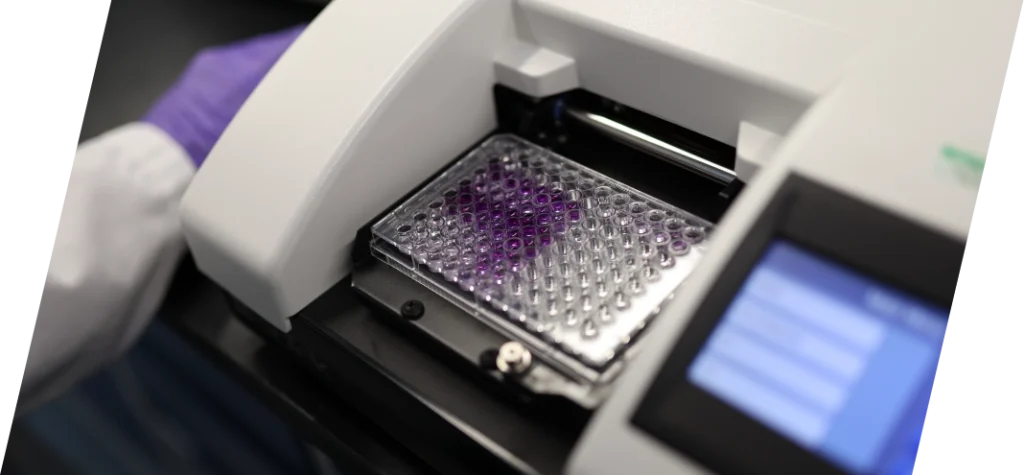In-Vitro Ophthalmological Testing
- FDA Registration FEI# 1000151293 as a GMP/GLP/GCP Drug Establishment and Cosmetic Facility.
- DEA Registration# RC0199744 (Analytical Lab) | Schedule I-V license | Remember, Schedules I-II require DEA Form 222 | Registration# RC0171568 (Researcher)
- US EPA/NJ DEP Registration# NJD982726648
- ISO/IEC 17025:2017 Accreditation# 80071
Products that may come into contact with the eyes require ophthalmologist-testing strategies to confirm that formulations do not irritate the eyes.
Products such as creams, serums and cosmetics applied to the face, as well as shampoos and conditioners, require these in-vitro testing strategies.

Formulation evaluation is necessary when introducing novel ingredients, ingredient vehicles, processing methods, or ingredient combinations and/or when making a specific safety claim (e.g., “Safe for Sensitive Eyes,” “Ophthalmologist Tested,” “Safe for Contact Lens Wearers,” etc.).
Ingredients should be evaluated for safety in the final product concentration ranges, both individually and when combined in the final product, to assess for the possibility of adverse interactions.
Tiered approaches to ophthalmologist testing examine all available data to produce a well-rounded safety evaluation. Typically, tiered approaches require a toxicological profile and clinical assessments.
Our In-Vitro Testing Capabilities
CPT℠ has state-of-the-art analytical, microbiological, clinical, photobiology, and in-vitro toxicology testing laboratories, all of which are at your disposal in the determining of product safety, efficacy and efficiency.
Using our specialized departments and well-respected lab facility, we test a wide range of products at CPT℠. Our in-house experts offer guidance to determine the efficacy of your products while ensuring compliance and accommodating your budgetary concerns.
CPT℠ can execute tiered approaches that include both toxicological profiling, as well as clinical assessments to help our clients substantiate ophthalmological claims. Severe eye irritants are evaluated by our team using several regulatory agency-accepted in-vitro and ex vivo ophthalmological tests, including but not limited to:
Hen’s Egg Test on the Chorioallantoic Membrane (HET-CAM) Assay
The HET-CAM (Hen’s Egg Test Chorio-Allantoic-Membrane) assay was developed for irritation studies as an alternative method to replace the Draize ocular irritation test. It can be used to determine quickly, reliably and inexpensively, the ocular irritation potential of virtually all product types.
EpiOcular EIT
The EpiOcular EIT is an in-vitro assessment assay that has the ability to differentiate articles that are ocular irritants from articles that are not ocular irritants. The EIT is accepted as OECD TG 492.
EpiOcular Sub Draize Ultra-Mildness Test
This assay is routinely utilized for mild materials for which the Draize test is insensitive. This highly reproducible assay allows for quantifiable discrimination among mild, milder and mildest product formulations.
EpiOcular MTT ET-50 – Neat
The EpiOcular MTT ET-50 (Neat) method is a risk assessment assay based on the effective time at which a material (applied neat) causes a 50% reduction in tissue viability (ET-50). Based on the ET-50, the test article is categorized into one of 4 classifications ranging from non-irritating to severe/extreme, which correspond to groupings of Rabbit Draize Eye Scores (MMAS).
EpiOcular MTT ET-50 – Dilution
The EpiOcular MTT ET-50 (Dilution) method is similar to the MTT ET-50 Neat method. This assay is based on the effective time at which a material (diluted to 20% in water) causes a 50% reduction in tissue viability (ET-50). Based on the ET-50, the test article is categorized into one of 4 classifications ranging from non-irritating to severe/extreme which correspond to groupings of Rabbit Draize Eye Scores (MMAS). This method is recommended for surfactant-based solutions and is applicable to water-soluble materials with a specific gravity of > 0.95.

